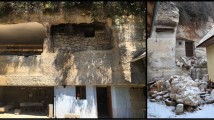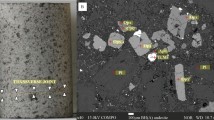Abstract
Frost damage due to freeze–thaw activity in hard rocks is a process that influences the appearance of the geo-relief of the landscape. Methods of frost damage assessment in rocks are based on parameters obtained mainly by destructive testing of samples. In this paper, nondestructive methods for the determination of pore connectivity as an important topological parameter affecting the migration of the fluid in rock material, as well as its variability due to freeze–thaw cycling, were employed. Tuff, andesite, and travertine, as well as two types of sandstones, were subjected to spontaneous imbibition testing. Based on the variation of the diffusion front with time, the slope of imbibition curve- C(I) was estimated and compared before and after 100 freeze–thaw thermal cycles. The samples were tested within a temperature range from − 10 to 10 °C in a fully saturated state in a controlled thermal chamber. Imbibition slopes were analyzed for fast (0.1–1 min) and medium (1–10 min) time intervals due to the variable petrophysical properties of the tested rocks. A considerable increase in imbibition slopes was detected, making the C(I) value a promising parameter that characterizes the interconnectivity of pores inside porous rocks. This parameter, in combination with the length of ice crystallization tc obtained from a thermistor probe located in the center of saturated dummy samples prepared from the same rock type subjected to freeze–thaw cycling, is capable of giving important indications of the degradability of rocks due to frost damage.










Similar content being viewed by others
Data availability
All samples of sandstones from the Pravčická Brána locality in the Bohemian Switzerland National Park (Czech Republic) and samples of andesites from the Babina quarry were taken with the consent of the competent authorities and in the presence of employees of the relevant institutions.
Code availability
Not applicable.
Change history
11 October 2021
A Correction to this paper has been published: https://doi.org/10.1007/s10064-021-02468-z
References
Bear J (1972) Dynamics of Fluid in Porous Media New York
Bruce RR, Klute A (1956) The measurement of soil- water diffusivity. Soil Science Society of America Proceedings 20:458–462
Deprez M, De Kock T, De Schutter G, Cnudde V (2020) A review on freeze-thaw action on weathering of rocks. Earth Sci Rev 203:103143. https://doi.org/10.1016/j.earscirev.2020.103143
Dullien FAL (1992) Porous media: fluid trabensport and pore structure. 2nd ed. Academic Press San Diego: 574
Dunn JR, Hudec PP (1966) Water, clay and rock soundness Ohio. J Sci 66(2):153–167
Everett DH (1961) Thermodynamics of frost damage to porous solids. Trans Farday Soc 57(7):1541–1551
Everett DH, Haynes JM (1965) Capillary properties of some model pore systems with special references to frost damage. Re-Union Internationale des Laboratoires d´Essois et de Recherches sur les Matereaux et les Constructions, R.I.L.E.M. Bull New Ser 27:31–38
Fukuda M (1974) Rock weathering by freezing-thawing cycles. Low Temp Sci Ser A 32:243–249
Fukuda M, Matsuoka N (1982) Pore-water pressure profile in freezing porous rocks. Low. Temp. Sci. Ser A 41:217–224
Fukuda M (1983) The pore water pressure in porous rocks during freezing. In: Proc. 4th Int. Conf. Permafrost. Natl. Academy Press, Washington, D.C.: 332–327
Greif V, Brcek M, Vlcko J, Varilova Z, Zvelebil J (2017) Thermomechanical behavior of Pravcicka Brana Rock Arch (Czech Republic). Landslides 14:1441–1455
Hirschwald J (1908) DiePrüfung der naturlichen Bausteineaufihre Verwitterungs beständigkeit. Verlag Wilhelm Ernst & Sohn, Berlin ([In German])
Handy LL (1960) Determination of effective capillary pressures for porous media from imbibition data. Petroleum Transactions AIME 219:75–80
Hu MQ, Persoff P, Wang JSY (2001) Laboratory measurement of water imbibition into low-permeability welded tuff. J Hydrol 242:64–78
Hu Q, Ewing RP, Dulz S (2012) Low pore connectivity in natural rock. J Contam Hydrol 133:76–83. https://doi.org/10.1016/j.jconhyd.2012.03.006
Chen T.-Yeung M.- Mori N (2004) Effect of water saturation on deterioration of welded fuff due to freeze-thaw action. In Cold Regions Science and Technology 38:127–136
Liu S, Hao L, Xianmin G, Zhiming R (2015) Experimental study on crystallization process and freezing properties of ice slurry generation based sodium chloride solution In: The 7th Inter. Conf. On Applied Energy 75: 1445–1451
Maľa M, Greif V, Ondrášik M, Macková A (2021) Changes in pore characteristics of travertines from Spišské Podhradie after repeated freeze-thaw cycles. AGEOS 13(1):119–128
McGreevy J, P& Whalley WB (1982) The geomorphic significance of rock temperature variations on cold environments. A Discussion Arctic and Alpine Research 14(2):157–162
Nakamura K, Jacob KH, Davies JN (1977) Volcanoes as possible indicators of tectonics stress orientation- Pure and Applied Geophysics. Aleutians and Alaska 115:87–112. https://doi.org/10.1007/BF01637099
Navratilova P (2017) Change in length and linear expansion force as an indicator of frost resistance of rocks. PhD Thesis, Comenius University in Bratislava (in Slovak)
Navratilová P (2017) Zmena dĺžky a lineárnej expanznej sily ako indikátor odolnosti hornín voči mrazu. Dizertačná práca, Univerzita Komenského v Bratislave ,74 p (In Slovak)
Philip JR (1957) The theory of infiltration: 4. Sorptivity and algebraic infiltration equations. Soil Sci 84:257–265
Powers TC (1949) The air requirements of frost-resistant concrete. Portland Cement Association, Chicago
Prick A (1995) Dilatometrical behaviour of porous calcereous rock samples subjected to freeze- thaw cycles. CATENA 25(1–4):7–20. https://doi.org/10.1016/0341-8162(94)00038-G
Ruedrich J, Siegesmund S (2006) Salt and ice crystallization in porous sandstones. Environ Geol 52:225–249. https://doi.org/10.1007/s00254-006-0585-6
Scherer GW (1999) Crystallization in pores. Cem Concr Res 29:1347–1358. https://doi.org/10.1016/S0008-8846(99)00002-2
Scherer GW, Valenza JJ (2005) Mechanisms of frost damage. Mater Sci Concr VII:209–246
STN EN 12371 (2010) Natural stone test methods. Determination of frost resistance. SÚTN (in Slovak)
STN EN 1936 (2007) Natural stone test methods. Determination of real density and apparent density, and of total and open porosity. SÚTN (in Slovak)
STN 72 1011 (1982) Laboratory determination of apparent density of solid particles of soils.
Stockhausen N (1981) Die Dilatation hoch poröser Festkörper bei Wasser auf nahmeund Eisbildung, Ph.D. TU München, [In German].
Tharp TM (1987) Conditions for crack propagation by frost wedging. Geol Soc Am Bull 99(1):94–102
Vlahou I, Worster MG (2010) Ice growth in spherical cavity of porous medium. J Glaciol 56(196):271–277. https://doi.org/10.3189/002214310791968494
Walder J, Hallet B (1985) A theoretical model of the fracture of rock during freezing. Geol Soc Am Bull 96(3):336–346
Yang, R, He S, Liu Y, Hu Q (2019) Pore structure, wettability, and their coupled effects on tracer-containing fluid migration in organic-rich shale. Petrophysical characterization and fluids transport in unconventional reservoirs :133–154 https://doi.org/10.1016/B978-0-12-816698-7.00007-3
Funding
This work was supported by a VEGA grant from the Slovak Ministry of Education (contract nos. 1/0503/19 and 1/0205/18) and the Comenius University Grant for Young Scientists (no. UK/244/2019).
Author information
Authors and Affiliations
Contributions
All authors contributed to the study conception and design. Material preparation, data collection, and analysis were performed by Martin Maľa and Vladimír Greif. The first draft of the manuscript was written by Martin Maľa, and all authors commented on previous versions of the manuscript. All authors read and approved the final manuscript.
Corresponding author
Ethics declarations
Ethics approval
Not applicable.
Consent to participate
Not applicable.
Consent for publication
Not applicable.
Competing interests
The authors declare no competing interests.
Additional information
The original online version of this article was revised: The above article was published online with error in figures 2-3. The figures are now correctly replaced.
Rights and permissions
About this article
Cite this article
Maľa, M., Greif, V. Effect of frost damage on the pore interconnectivity of porous rocks by spontaneous imbibition method. Bull Eng Geol Environ 80, 8789–8799 (2021). https://doi.org/10.1007/s10064-021-02452-7
Received:
Accepted:
Published:
Issue Date:
DOI: https://doi.org/10.1007/s10064-021-02452-7




